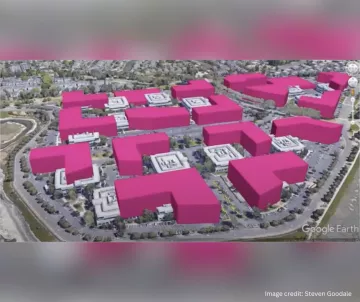What is Happening

Redwood City is considering a massive new biotech development project, spanning over 25 years of demolition and construction, that could negatively affect wetland ecosystems and shorebirds at the Redwood Shores Ecological Reserve as well as the health and safety of residents.
The developer, Longfellow, has asked for a new zoning plan that would allow new development at three times the size and intensity of buildings currently in the project area. The result would be 130 ft-tall high-rises permitted to work with hazardous organisms such as influenza and COVID-19. The daily operations of biolabs routinely involve hazardous materials transport and storage, creating environmental and public health risks. Along with these massive structures and high risk uses would be the shrinking of setbacks that protect ecosystems and community members. Close to the project site are multifamily residential neighborhoods with a library, schools and housing.
In addition, the proposed development site includes 45 acres of a former landfill, contaminated with heavy metals and volatile organic compounds in leachate, groundwater and surface water. The current site plans do not account for sea level or groundwater rise, which is troubling considering it is a closed landfill with municipal and industrial waste. Flood protection levees will not protect against groundwater rise infiltrating the waste from below and leaching out into the slough or spreading soil-borne toxins well beyond the original source.
Why it Matters
The Sierra Club and other environmental groups have raised concerns about potentially substantial impacts on the environment and public health. The Loma Prieta Chapter opposes new bio lab development (biosafety hazard levels BSL-3 and BSL-4) in populated areas and in proximity to sensitive habitats - and cities are beginning to agree. San Carlos now prohibits BSL-3 and BSL-4 projects throughout city limits and Redwood City itself has banned such projects in the downtown area. The residents of Redwood Shores and the Redwood Shores Ecological Reserve deserve similar protections.
Large buildings can themselves be highly disruptive for nearby ecosystems. These buildings shade habitat from the natural sunlight they would normally receive, changing the behavior of wildlife. Reducing building setbacks also increases the disruption of local habitat. Buildings with artificial light and reflective windows can cause artificial light to shine into ecosystems that should be dark at night. These lights and windows also are a serious hazard for local and migratory birds which can collide with these structures.
Furthermore, structural support for massive and taller new development on this site could require piercing the landfill’s clay cap hundreds of times, disrupting the protections currently in place to prevent contamination. Failing to take the site's status as a landfill, subject to California’s waste disposal requirements into account, along with the compounding threat of mobilized soil-borne toxins due to groundwater rise, would be a critical misstep.
The longstanding Westport Specific Plan, by contrast, has already established protections that should be preserved. These protections include limitations on building heights to “no higher than 3 stories as long as they are set back 260 feet.”
Bay Alive Goals
- Preserve the Westport Specific Plan and the protections within.
- Adopt and implement Bird-Safe and Dark Sky standards to reduce bird strikes and light pollution.
- Avoid the negative community and environmental impacts of biosafety labs.
- Identify and plan for groundwater rise vulnerability, protect against existing contamination risks, and avoid introducing new ones.
Resources
- Redwood LIFE project on the Redwood City website
- Bio safety advocates concerned over upcoming lab in Redwood City, RWC Pulse August 28, 2023
- Prematurity of the New Redwood Life Precise Plan and EIR, June 23, 2023 Conservation Letter